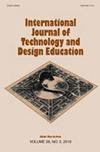沉浸式技术在设计教育同步混合学习中的实证研究
IF 2.7
3区 工程技术
Q2 EDUCATION & EDUCATIONAL RESEARCH
International Journal of Technology and Design Education
Pub Date : 2023-10-24
DOI:10.1007/s10798-023-09855-5
引用次数: 0
摘要
沉浸式技术在设计教育中发挥着越来越重要的作用,支持高等教育中的数字素养和体验式学习,特别是在covid -19后的背景下。许多设计学科,如建筑和景观设计,过去严重依赖实地考察和对话工作室作为标志性的教学方法,由于面对面教学和学习的暂停,不得不适应创新教育技术的扩散。增强现实和虚拟现实现在广泛应用于技术和设计教育,以支持更加互动、协作和以学生为中心的学习方法。本文扩展了一项关于从传统的以工作室为基础的设计教育的标志性教学法向技术增强的协作学习过渡的试点研究,以支持体验式学习。本文以Kolb的体验式学习框架为基础,对具体体验(CE)、反思观察(RO)、抽象概念化(AC)和主动实验(AE)四种学习模式进行分析,分析了香港三所不同高等教育机构的四组75名本科生的数据。调查了他们在设计和技术课程中同步混合虚拟体验式学习的体验。此外,对6名学生的经历进行了采访。研究结果证实了两个研究假设,即沉浸式体验学习可以建设性地协调RO和AE,从而对体验学习过程产生总体的积极影响,但对促进CE,特别是AC没有决定性的影响。定量发现和定性结果为讨论本研究的理论和实践意义提供了新的见解。本文章由计算机程序翻译,如有差异,请以英文原文为准。
An empirical study on immersive technology in synchronous hybrid learning in design education
Abstract Immersive technology plays an increasingly important role in design education, supporting digital literacy and experiential learning in higher education, particularly in the post-COVID-19 context. Many design disciplines, such as Architecture and Landscape Design, which used to rely heavily on physical field trips, and dialogic studios as signature pedagogies, had to adapt to the proliferation of innovative educational technologies due to the suspension of face-to-face teaching and learning. Augmented reality and virtual reality are now extensively used in technology and design education to support a more interactive, collaborative, and student-centred approach to learning. This paper expands on a pilot research study on the transition from traditional signature pedagogies of studio-based design education to technology-enhanced collaborative learning to support experiential learning. Based on Kolb’s experiential learning framework concerning four learning modes, namely, concrete experience (CE), reflective observation (RO), abstract conceptualisation (AC), and active experimentation (AE), this paper analyses data from 75 undergraduate students across four cohorts in three different higher education institutions in Hong Kong. They were surveyed on their experiences of synchronous hybrid virtual experiential learning with design and technology curricula. Furthermore, six students were interviewed about their experiences. The research findings confirm two research hypotheses showing that immersive experiential learning could constructively align RO and AE, thus bringing an overall positive impact on the experiential learning process, but shows no conclusive influence on promoting CE, especially AC. The quantitative findings and qualitative results gave new insights into the discussion of the theoretical and practical implications of the study.
求助全文
通过发布文献求助,成功后即可免费获取论文全文。
去求助
来源期刊
CiteScore
5.30
自引率
19.00%
发文量
61
审稿时长
>12 weeks
期刊介绍:
The International Journal of Technology and Design Education seeks to encourage research and scholarly writing about any aspect of technology and design education. Critical, review, and comparative studies are particularly prominent, as are contributions which draw upon other literatures, such as those derived from historical, philosophical, sociological or psychological studies of technology or design, in order to address issues of concern to technology and design education.
One of the most significant developments of recent years has been the emergence of technology and design education as an integral part of general education in many parts of the world. Its distinctive curriculum features are technological literacy and capability and it highlights the importance of `knowledge in action'', of `doing'' as well as `understanding''.

 求助内容:
求助内容: 应助结果提醒方式:
应助结果提醒方式:


